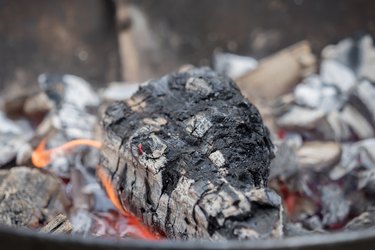
The 360-degree view of an indoor fire pit with chimney brings the ambiance of a campfire indoors. The construction of an open pit fireplace outdoors is much less complicated than the task of bringing one indoors, as there are many more safety precautions that must be handled to make it safe for indoors. Among other considerations, a chimney or hood system carries away heat, ashes, combustion gases and smoke. Glass or screen fires surrounding the open pit fireplace also protect the room against sparks.
Moving From Outdoors to Indoors
Video of the Day
When bringing a fire pit indoors, a safe and suitable spot should be chosen ahead of time. There are a number of different types of indoor fire pit fireplaces, ranging from electric to gas to propane to bioethanol to wood-burning. There are also tabletop-size fire pits available for small spaces.
Video of the Day
For best viewing, the fire pit should be placed away from flammable objects and preferably in the center of the room. Wood-burning and some gas fire pits need a chimney or fire hood that can be constructed into the ceiling to draw the heat and combustion gasses out and prevent heat and fire damage. Wood-burning fire pits also require a fire pit pad, stone slab, or bricks underneath, which prevents ashes from falling directly onto the flooring and potentially causing a fire. Before purchasing or constructing an indoor fire pit, consult with the local building department to ensure that you comply with fire safety regulations.
Constructing the Fire Pit
When building your own indoor fire pit, the protective floor covering is installed first, then a stone, brick or block wall is constructed in a circle to form the exterior. The wall of the fire pit may also be formed of resilient metals such as steel or copper. The wall should be no less than 1 1/2 feet and up to 3 or 4 feet tall. Fireproof blocks and bricks are available at home improvement stores and fit together easily; use mortar to secure the materials.
Once you have installed the fire pit wall, add a steel lining to protect the bricks from receiving too much heat and deteriorating prematurely. In the case of gas-fueled fireplaces, the gas supply lines are installed before the pit is filled with a layer of sand and a 6-inch layer of gravel or lava rocks. The sand and gravel add further protection to the floor below.
Providing Protective Elements
Because the open pit fireplace is indoors and the heat and ash produced by burning wood cannot float away in the breeze, it requires a chimney or fire hood. The chimney or hood should be made of materials that are resistant to fire and create a pathway for the smoke to exit the home. An integral fan in the hood pulls the particulate matter in the smoke and carbon monoxide from the home.
Include a glass or mesh cover to stretch between the fire hood and the fire pit to prevent flyaway ashes from causing fires and to prevent little ones from injuring themselves. In addition, a combination smoke and carbon monoxide detector warns you and the family if the fire escapes the fire pit and of hazardous gas buildup, which can be fatal.
Maintaining an Indoor Fire Pit With Chimney
While some outdoor fire pits and fireplaces are built to sit directly on the ground, this would require cutting a hole through the flooring, which is probably against local building codes, and could affect the structural integrity of your floor and foundation as well as giving rodents and vermin access to the interior of the house. These types of fire pits are best used outside on the patio and not inside the home.
Whether inside or outside, cooled wood ashes should be removed regularly to keep dust down. Place wood ashes in a fireproof container away from the exterior of the home to prevent reignition from hot coals and damage to siding. Inspect the chimney or fire hood regularly for creosote buildup that could easily start an unwanted fire.